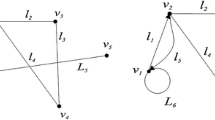Abstract
LetD(n, d) be a digraph chosen at random from a family of alld-out-regular digraphs onn points. LetK(n, p) be a simple graph onn points in which each edge appears independently with probabilityp. A relationship between the properties of extreme in-degrees ofD(n,d) and extreme degrees ofK(n, p) in the case whend = (n − 1)p = o(n) is presented. A sociological interpretation is also provided.
Similar content being viewed by others
References
Bollobás, B.: Vertices of given degree in a random graph. J. Graph Theory6, 147–155 (1982)
Bollobás, B.: Random Graphs. London: Academic Press 1985
Capobianco, M., Palka, Z.: The distribution of popular persons in a group. Social Networks5, 383–393 (1983)
Erdös, P., Rényi, A.: On the strength of connectedness of a random graph. Acta Math. Acad. Sci. Hung.12, 261–267 (1961)
Ivchenko, G.: On the asymptotic behaviour of degrees of vertices in a random graph. Theory Probab. Appl.18, 188–195 (1973)
Palka, Z.: On the number of vertices of given degree in a random graph. J. Graph Theory8, 167–170 (1984)
Palka, Z.: Some remarks about extreme degrees in a random graph. Math. Proc. Camb. Philos. Soc. (in press)
Palka, Z.: Extreme degrees in random graphs. J. Graph Theory (in press)
Palka, Z.: Asymptotic Properties of Random Graphs (in press)
Palmer, E.: Graphical Evolution, An Introduction to the Theory of Random Graphs. New York: Wiley 1985
Author information
Authors and Affiliations
Rights and permissions
About this article
Cite this article
Palka, Z. Rulers and slaves in a random social group. Graphs and Combinatorics 2, 165–172 (1986). https://doi.org/10.1007/BF01788089
Received:
Revised:
Issue Date:
DOI: https://doi.org/10.1007/BF01788089




